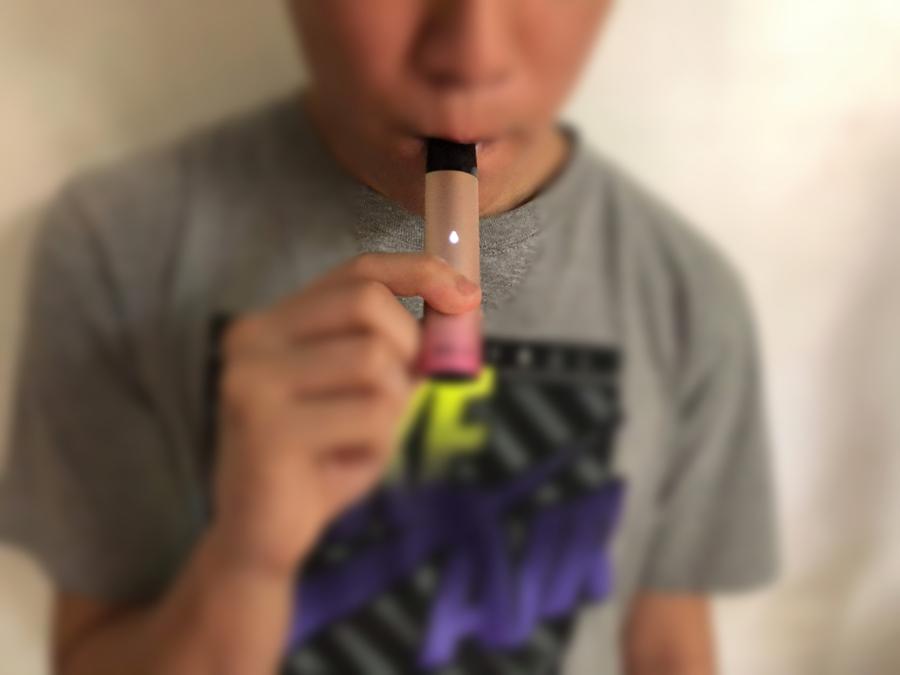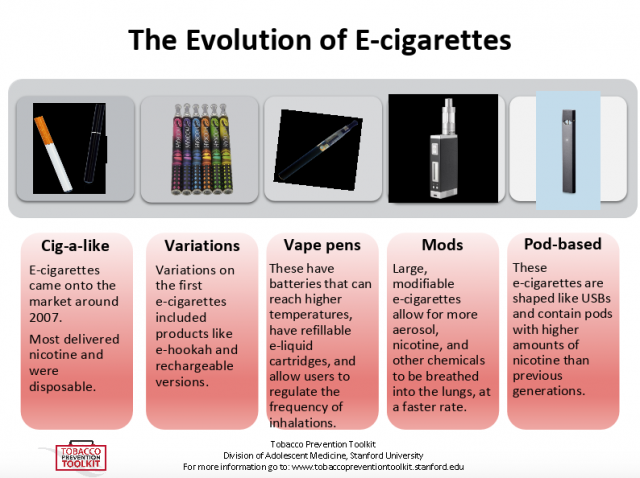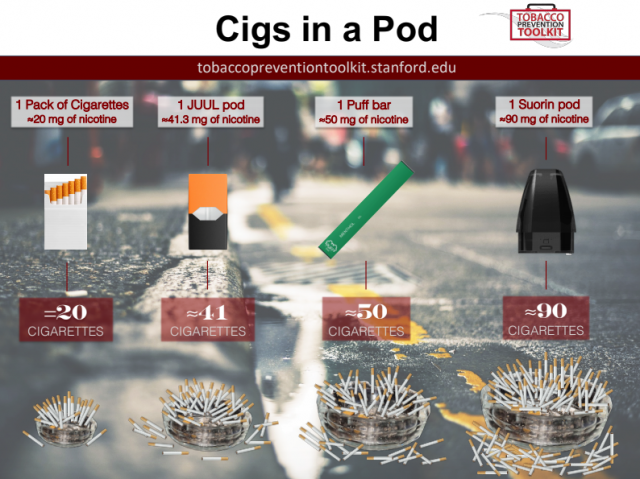How the COVID-19 crisis could be the best time for parents to help kids quit vaping

Lisa* was having fun on a family vacation abroad. She, her two teenage kids, and her husband were on a road trip in a rental car. Lisa was having the time of her life—until her son told her that his sister, Bea*, had been Juuling in the back seat during the drive.
Juuling, which is essentially vaping, was coined after the sleek electronic cigarette became so popular, the brand became a verb.
E-cigarettes, which come in many shapes and sizes, all work the same way. They heat a flavored liquid containing highly addictive nicotine.

Lisa was shocked. “That is so rude! And I didn’t smell anything,” she says. Before the trip, Lisa found the USB-like device in the 19-year-old’s room. She then lectured her daughter on the harms of vaping.
But Bea wouldn’t listen. The young fashionista — who learned to sew by watching videos online and sold her creations on Instagram — is a digital native. Bea fell for Juul’s youth-oriented marketing campaign: thousands of tweets, Facebook and Instagram posts, emails, and ads. She says, “If Bella Hadid is cool and a model and she vapes, it can’t be that bad.”
Little does Bea know that nicotine messes up the teenage brain. “Studies show that the young brain — specifically the prefrontal cortex responsible for impulse control, behavior, emotions, and higher learning — matures by age 25,” says pediatrician Dr. Rizalina R. H. Gonzalez.
In short, the nicotine in e-cigarettes can have devastating effects on the teen’s attention, learning, and memory. It may even contribute to developing anxiety disorders.
Lisa and other parents of teens who use e-cigarettes need to help their kids quit the harmful habit. Now could be the best time for them to help their kids break free from nicotine.
Addictive by design
Bea is just one of countless Filipino teens who are hooked on e-cigarettes. Alarmingly, one out of five e-cigarette users is aged 19 and below. This figure comes from the 2018 National Nutrition Survey by the Food and Nutrition Research Institute.
E-cigarettes are most popular among younger adults, including those aged 15 to 24 years (36.3%), according to the 2015 Global Adult Tobacco Survey.
Which types of e-cigarettes do Filipino teens use? No research has been conducted yet, but four of the six young vapers interviewed for this article use pod-type e-cigarettes. This may suggest that Filipino teens prefer the sleek gadgets to boxier vaping devices.
Juul is designed to look like a USB drive, an everyday item used by many teens. This makes it easy for them to hide the device in plain sight. No wonder mothers like Lisa and Eula* took their teen daughters’ Juul devices for a high-tech gadget plugged into their laptops. Eula says, “I simply thought it was another cute and colorful trinket that my daughter Hanna* uses.”
The pod-type e-cigarette’s design makes it easy for young vapers to use the device right under the noses of parents and teachers.
Karma McKelvey, Ph.D., M.P.H., and Bonnie Halpern-Felsher, Ph.D., surveyed California young adult users of pod-type e-cigarettes in 2019 and found that the most cited reason for using pods was that they are “easy to hide.”
Lisa’s son says that Bea was blowing the plume from her Juul into her shirt sleeves during the road trip. And the reason why Lisa didn’t smell anything unusual? Bea says, “If you inhale and hold it long enough, there won’t really be any smoke, or it will be light enough that you won’t see it.”
On the other hand, Eula was called to Hanna’s school after the 15-year-old was caught vaping on the premises. The teen was penalized. “Hanna was asked to render community service — sweeping the classroom floor, cleaning the whiteboards — for two half days on Saturdays,” says Eula.
Hanna’s case seems to be a rarity, though. It’s so easy to get away with vaping in school, says Mike*, 19, a college freshman. He says, “In college, I haven’t heard of anyone getting caught. In high school, none of us were ever caught.” At the university where he studies, he says students don’t even bother to hide their vaping devices. They leave their devices out in the open on cafeteria tables.
Pod-type e-cigarettes pack a lot of highly addictive nicotine in tiny pods. Nicotine hooks teen vapers — in fact, anyone who vapes or smokes cigarettes — by delivering a quick hit.

“Once in the lungs, it is readily absorbed into the bloodstream and distributed to the brain in about seven seconds,” writes neuroscientist Judith Grisel in her book “Never Enough: The Neuroscience and Experience of Addiction.”
Flavors are a critical part of the product design of pod-type e-cigarettes. Nicotine combined with kid-friendly sweet and fruity flavors—more than 15,500—in e-liquids entice teens into trying these e-cigarettes and quickly hook them. A University of Southern California study has found that “teens who vape candy- or fruit-flavored e-cigarettes are more likely to stick with the habit and vape more heavily.” The study implicates flavors in the teen vaping epidemic in the US.
Mike enjoys vaping with his friends, particularly when everyone has a different flavor. “Next thing you know, everyone is just passing their devices around,” he says. “It’s like a wine tasting.”
The variety of flavors is certainly one reason why Chris*, 20, vapes. He started vaping at age 16 and likes mint and candy flavors. When asked what would make him consider quitting, he replied, “if they limit the flavor to tobacco.”
Easier said than done
Ideally, parents can help their vaping teens, or prevent them from vaping in the first place, by keeping the lines of communication open. That’s easier said than done, though. Lisa’s strategy has been to be open with Bea.
“I told her how frustrated I was that she was doing it, gave her all these lectures, and sent her articles about how bad vaping is,” Lisa says. “She would listen but kept doing it.” She hopes that Bea is just going through a rebellious phase as part of growing up.
Eula is just too tired taking care of an ailing parent, who needs round-the-clock care, to give a vape talk to Hanna. She sees little enough of her daughter and, instead of lecturing Hanna, she prefers to “say pleasant things” to her. Eula says, “I wish there would be talks in school, where kids spend a lot of time, about the dangers of vaping.”
A window of opportunity
Experts like Dr. Gonzalez and Dr. E. Ulysses Dorotheo both believe that the COVID-19 pandemic provides parents like Lisa and Eula with a golden opportunity to help their teens quit vaping and avoid using tobacco in any form.
The pediatrician’s definition of staying safe during this crisis is “no vape, no tobacco.” Dr. Gonzalez says now is the best time to quit both vices because they result in “diminished defenses of the respiratory system, and this virus enters through the airways.”
Dr. Dorotheo, the executive director of Southeast Asia Tobacco Control Alliance, agrees. “Given that COVID-19 primarily affects the lungs, there is really a high risk that smokers and vapers will develop severe COVID disease,” he says.
Moreover, both vices could help spread the virus. “If you are a carrier of the coronavirus and you are smoking or vaping, you can actually transmit the virus through the secondhand smoke or aerosol,” says Dr. Dorotheo.
That’s bad news for Mike and vapers like him who share devices with their friends and are exposed to each other’s secondhand aerosol.
The Philippines’ coronavirus crisis did do something that Lisa could not. It gave Bea the push she needed to stop vaping. First, it cut her access to pods. When the Metro Manila lockdown started on March 15, 2020, Bea’s usual sources — mall-based vape stores and supermarkets — temporarily closed.
She got four mint pods from a friend a few days before the lockdown. But when Bea ran out of pods on April 15, she was unable to buy any because the stores were still closed. When this writer spoke to Bea on April 30, she had been vape-free for two weeks.
The global pandemic also gave Bea a real enemy to fear. Before the health crisis, the news about the vaping deaths in the US made her anxious. These events, however, were too remote to give her pause.
Bea has since changed her tune. By the end of April, the teen who literally vaped under her parents’ noses was scared that her vice might lead to her contracting the dreaded COVID-19 disease. She says, “I already do a lot of extra things to keep safe like wearing a mask and bringing my alcohol spray everywhere. If I would just throw all that away just because I want to vape, it’s just not worth it.” — LA, GMA News
*Names have been changed to protect the identity of the interviewees.
This story was produced under the “Nagbabagang Kuwento Media Fellowship Program Cycle 4” by Probe Media Foundation Inc. (PMFI) and Campaign for Tobacco-Free Kids (CFTFK). The views and opinions expressed in this piece are not necessarily those of PMFI and CFTFK.



